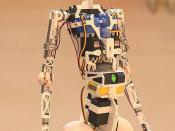Human cloning is very real and just around the corner. In the simplest language, cloning is the process in which the DNA from some cell of a body is put by electrical shock into a female egg cell whose DNA has been removed. Then the egg cell is implanted into a womb, and after that it grows the same as a natural baby does. In the 1970's, two scientists from Stanford University in California first developed the process of cloning. However, the experiments were only done with toads and frogs. The cloning process has never been done with a human. The idea that scientific research could actually produce cloned humans is something that probably disturbs most of us. Cloning a human is a very delicate and dangerous process that hasn't totally been figured out yet. Human lives are not research materials, and scientists should not have control over a person's identity and unique characteristics.
The health risks cloning poses, the growth in violence and crime, the arising of a black market, exploitation of women, as well as the moral and ethical questions raised by cloning, are reasons why human cloning should be banned.
Clones have defects, which aren't obvious. Humans have not yet been successfully cloned, but on other animals, such as mice and sheep, there have been definite problems. According to the National Academy of Sciences in Washington D.C., recent research indicates that even though a clone may be exactly like their real counterpart, he may have strong hidden DNA defects. Researchers found some sobering information while scanning the DNA of cloned mice. One out of every twenty-five genes was "abnormally expressed". The cloned mice also experienced rapid aging and often died prematurely. Dolly the sheep, the world's first clone, created in 1996, has developed arthritis and is being...



WOW
Very Ineteresting i really walked away and learned something.
1 out of 1 people found this comment useful.